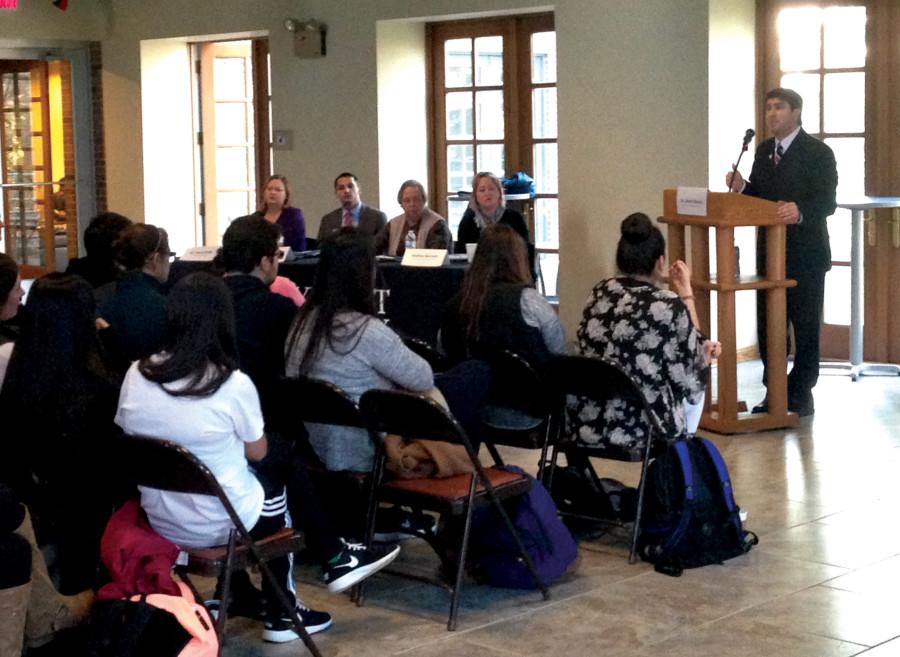Faculty restructuring to occur in coming semester
David Dausey, Ph.D., and a panel of faculty addressed questions from students regarding the structural changes that will take effect next fall.
February 6, 2016
Mercyhurst will undergo more restructuring as it plans to “right-size” its faculty and keep up with market trends, university officials announced.
The university will take a “multi-faceted approach” to reducing the number of faculty, according to David Dausey, Ph.D., provost and vice president for academic affairs.
“What’s happened organically, probably over the last five years, has been that the faculty growth has outpaced student growth,” said Dausey. “Our student numbers have dropped by nine percent. Our faculty grew by 20 percent.”
To begin adjusting this imbalance, the university will offer incentivized voluntary retirement to older faculty, he said. Cutting majors or programs remains a possibility.
“We feel it’s consistent with our Mercy Mission. We feel it’s a fair and honorable way to offer somebody recognition for their service to the organization,” Dausey said.
Another part of this strategy is not renewing year-to-year contracts for some non-tenured faculty members.
The reductions in faculty would take place in the 2016-17 academic year.
“Our primary focus is to be responsible stewards of our money,” Dausey said.
Dausey met with several Merciad editors on Friday.
The entire faculty and staff have had a freeze on salary for three of the last four years, and there is currently a hiring freeze in place. Dausey said the university will be creative with the resources it has now until it is in a position to hire responsibly.
“It’s hard to know (how many faculty will be cut) until we present people with offers and they decide whether or not they want to accept them,” he said.
Dausey said he hopes senior faculty who choose to accept the retirement incentives stay in close contact and come back to the university and serve in a professor emeritus status.
All decisions will be made by the end of spring term, according to Dausey.
Cutting majors or academic programs will be a last resort, Dausey said.
“There are often times for the reinvention of things, you know the digital humanities, media studies in general,” said Dausey. “We may take those actions to rebrand or to shift resources in such ways that it is represented of what we feel is the new thing.”
Dausey said the administration take the caretaking of the institution very seriously.
“It doesn’t happen by accident. The Sisters [of Mercy], through blood, sweat and tears, kept this place humming and it’s our job to do the same thing and that sometimes involves making hard decisions,” said Dausey. “Those hard decisions, as challenging as they be, are ones that are for the betterment of the institution.”


Mathew Jury • Feb 6, 2016 at 3:03 am
Too bad it has to come to this, but when I see how other schools are faring with budget issues, I consider ourselves lucky. Personally, I feel one way to alleviate our woes would be to hire more student workers. Why hire outsiders when you can provide financial aid to students willing to work for the school? Also, I might suggest allowing students a say in what faculty are kept. If there are highly incompetent faculty hired here, students should have the right to seek their removal. We should not have to cut any of the faculty most of the student body feel do the school justice.
Also, when you think about it, Catholic schools in general had few funding problems back in the older days pre-VII where there was a high presence of consecrated religious people (in our case, the Sisters of Mercy). This was due to the fact that religious orders viewed education as a religious duty rather than a paid job. After the Second Vatican Council of 1963, multiple heretical interpretations of the documents (not the council teachings themselves) led to some religious orders to abandon their fidelity to the church, including the disuse of the habits. Since then, religious orders have been dying out, resulting in Catholic schools either hiring lay faculty or closing down due to the need to pay lay faculty. I don’t feel we should get rid of the great lay faculty we have here, but we need to consider hiring more religious faculty that will be willing to work for the sake of service. Research has found that new orthodox religious orders or orders that have remained orthodox have more people entering their orders than the “Spirit of Vatican II” type orders who abandon fidelity to the Church in the name of “social justice”. Just read up on the Poor Clares of Perpetual Adoration from Alabama, the Little Sisters of the Poor, and the Slaves of the Immaculate Heart of Mary, which have more members coming in yearly than lost. Various religious orders that abandon orthodoxy, sadly including some patches of the Sisters of Mercy, are losing more members than gaining. If religious orders can return to orthodoxy, they will have a massive increase in vocations, resulting in having more people available to run Catholic schools, including our fair university. Hire more religious faculty (actually religious, not “Spirit of Vatican II” type) and we will have less worries about financial woes. It would be nice for various local churches to take up collections to support our Catholic colleges so we might have less worries about finances.
I may not seem like what I am talking about and, to a degree, I probably don’t. I am just pointing out that Catholic schools in the past succeeded because of religious orders having more members willing to educate for the service to God. Coincidentally, it is the orthodox orders of today that have the numbers that I wish all orders still had. May God guide us out of this financial worry and lead us to a bright future as a Mercy school. Carpe Diem!